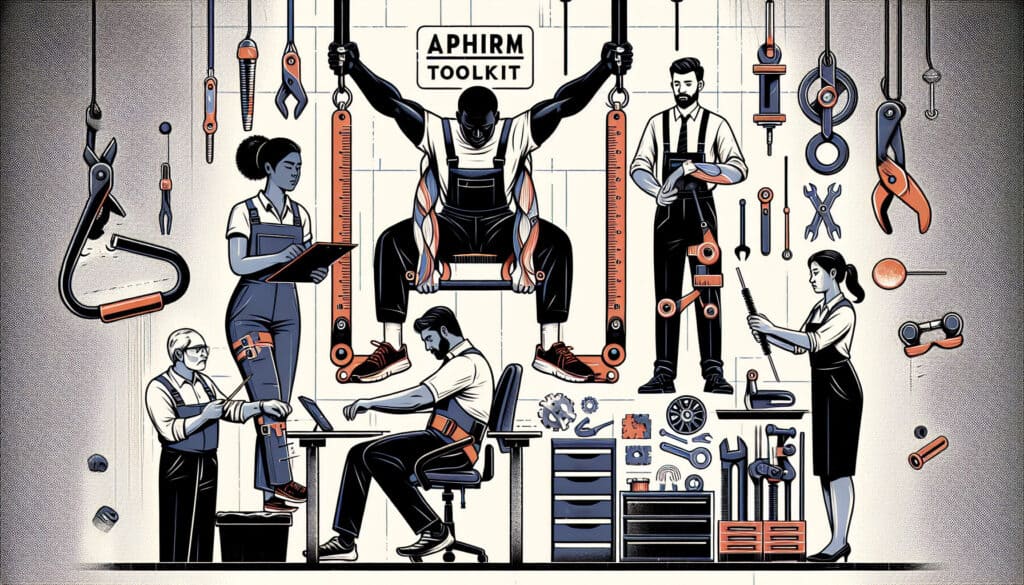A toolkit of resources developed in Australia to help organizations manage the risks of musculoskeletal disorders.
- Methodologies: Ergonomics
APHIRM Toolkit

APHIRM Toolkit
- Continuous Improvement, Ergonomics, Health Sciences, Human Factors, Process Improvement, Quality Management, Risk Management, Safety, Sustainability Practices
Objective:
How it’s used:
- The APHIRM (A Participative Hazard Identification and Risk Management) toolkit provides a step-by-step guide to identifying, assessing, and controlling musculoskeletal hazards in the workplace. It includes a range of practical tools, such as checklists and worksheets.
Pros
- Provides a practical and easy-to-use framework for managing musculoskeletal risks, is based on a participative approach, and has been developed specifically for Australian workplaces.
Cons
- May not be applicable to all countries or industries, requires a commitment from management and workers to be effective, and may not be suitable for all types of musculoskeletal hazards.
Categories:
- Ergonomics, Human Resources, Risk Management
Best for:
- Managing the risks of musculoskeletal disorders in Australian workplaces.
The APHIRM Toolkit is particularly valuable in industries such as healthcare, manufacturing, and logistics, where manual handling and repetitive tasks are prevalent. It is applicable throughout various project phases, including initial design, implementation, and ongoing maintenance. A multidisciplinary team, including health and safety officers, ergonomic specialists, and front-line workers, typically initiates the risk assessment process, ensuring that insights and experiences from those directly affected inform the evaluation of hazards. The participative nature of the toolkit allows for input from a diverse range of stakeholders, making it adaptable to different workplace environments and practices. The practical tools, such as checklists and worksheets, promote engagement and facilitate straightforward applications, regardless of the existing level of expertise in risk management. Regularly integrating the APHIRM methodology into workplace safety programs not only promotes compliance with Australian Safe Work regulations but also encourages a culture of safety that aims to reduce the incidence of musculoskeletal disorders. By ensuring that risk management is a shared responsibility, workplaces can foster ongoing dialogues about safety measures, leading to continuous improvement in ergonomic practices and better health outcomes for employees. Through its integrated approach, the toolkit also serves as a blueprint for conducting training sessions and workshops focused on risk identification and mitigation strategies, empowering teams to proactively address issues related to musculoskeletal health.
Key steps of this methodology
- Identify musculoskeletal hazards through workplace evaluations and observations.
- Assess the level of risk associated with identified hazards using qualitative or quantitative measures.
- Engage stakeholders in developing control strategies to mitigate identified risks.
- Implement the chosen control measures and ensure that all staff are informed.
- Monitor the effectiveness of the implemented controls and gather feedback from employees.
- Review and update the risk management process regularly to reflect changes in the workplace or emerging risks.
Pro Tips
- Incorporate ergonomic assessments into regular workflow evaluations to identify subtle hazards that may not be immediately visible.
- Utilize feedback loops from participating employees to continuously refine and improve risk management strategies based on real experiences.
- Leverage data analytics tools to monitor trends in musculoskeletal disorders and adapt interventions proactively based on identified patterns.
To read and compare several methodologies, we recommend the
> Extensive Methodologies Repository <
together with the 400+ other methodologies.
Your comments on this methodology or additional info are welcome on the comment section below ↓ , so as any engineering-related ideas or links.
Historical Context
1986
(if date is unknown or not relevant, e.g. "fluid mechanics", a rounded estimation of its notable emergence is provided)

Related Posts
Monte Carlo Simulation
Model-Based Testing
Model Checking
Mixed Methods Research
Mistake Proofing (Poka-Yoke)
Mission Profile Testing